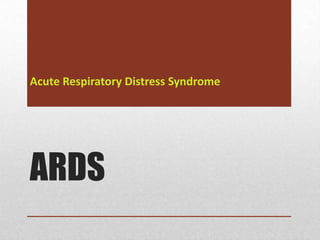Ard spresentation
- 1. Acute Respiratory Distress Syndrome ARDS
- 2. Overview âĒ Previously called Adult Respiratory Distress Syndrome âĒ Defined in 1994 American-European Consensus Conference on ARDS: âĒ Most sever Acute Lung Injury âĒ Diffuse alveolar damage âĒ Severe hypoxemia (PaO2/FIO2 < 200) âĒ Bilateral pulmonary infiltrates âĒ Absence of cardiogenic pulmonary edema (PCWP <18 mmHg)
- 3. Epidemiology âĒ 75 cases/ 100,000 population âĒ Can occur at any age âĒ Risks âĒ advanced age âĒ No sex preference âĒ female sex (only in trauma) âĒ cigarette smoking âĒ alcohol use. âĒ High APACHE score (any underlying cause)
- 4. Pathophysiology âĒ Diffuse alveolar damage âĒ Increased permeability âĒ Damage to alveolar or capillary endothelium âĒ Inflammation (cytokines, leukotrienes, TNF) âĒ Increased neutrophils ? Reactive âĒ Severe pulmonary shunting ïŪ hypoxemia âĒ Pulmonary hypertension
- 5. Causative Insults âĒ Sepsis âĒ Aspiration âĒ Trauma âĒ Drug overdose âĒ Fractures âĒ Near drowning âĒ Burns âĒ Cardiopulmonary âĒ Massive bypass transfusion âĒ Pancreatitis âĒ Pneumonia âĒ Fat embolism
- 6. Presentation âĒ Acute dyspnea and hypoxemia âĒ within hours to days of an inciting event âĒ Critically ill âĒ Dyspnea, rapidly progressing âĒ Tachypnea âĒ Agitation âĒ Increasing O2 demands âĒ Often multisystem organ failure
- 7. Physical Exam âĒ Unspecific âĒ Tachypnea âĒ Tachycardia âĒ Cyanosis âĒ Rales âĒ Sepsis âĒ Hypotension âĒ Peripheral vasoconstriction âĒ Manifestation of the underlying cause âĒ i.e abdominal finding pancreatitis
- 8. Differential Diagnosis âĒ Pulmonary hemorrhage âĒ Transfusion-related âĒ Near drowning acute lung injury (TRALI) âĒ Drug reaction âĒ Acute eosinophilic âĒ Noncardiogenic pneumonia pulmonary edema âĒ Reperfusion injury âĒ Hamman-Rich âĒ Leukemic infiltration syndrome âĒ Fat embolism syndrome âĒ Retinoic acid syndrome âĒ Acute hypersensitivity pneumonitis
- 9. Workup âĒ ABG âĒ Hypoxemia âĒ Respiratory alkalosis initially âĒ Respiratory Acidosis ( late) âĒ BNP- exclude cardiogenic pulmonary edema âĒ CXR diffuse bilateral infiltrates âĒ Echocardiogram âĒ Possible CT
- 10. Treatment âĒ Treatment is supportive + underlying cause âĒ No effective drug for prevention nor management âĒ Xigris âĒ Nitric Oxide âĒ Liquid surfactant âĒ New hopes âĒ Simvastatin âĒ TNF and interleukin antibodies
- 11. Treatment âĒ Fluid management âĒ Resuscitation vs. maintenance âĒ Negative fluid balance âdry side of normalâ âĒ Ventilation âĒ Lung protective âĒ High PEEP ( , low TV ( 6 mL/kg) âĒ Neuromuscular block- improved 90 day survival âĒ ECMO- no improved survival âĒ Proning- no improve survival âĒ Nutrition âĒ Enteral, antioxidants, eicosapentaenoic acid, and gamma-linoleic acid
- 12. Prognosis âĒ Mortality âĒ Before 1990 , 40-70% âĒ Recent 30-40% âĒ Better understanding and treatment of sepsis. âĒ Increased in older patients âĒ Morbidity âĒ VAP âĒ Weight loss/muscle weakness âĒ Only 49% survivors return to work












